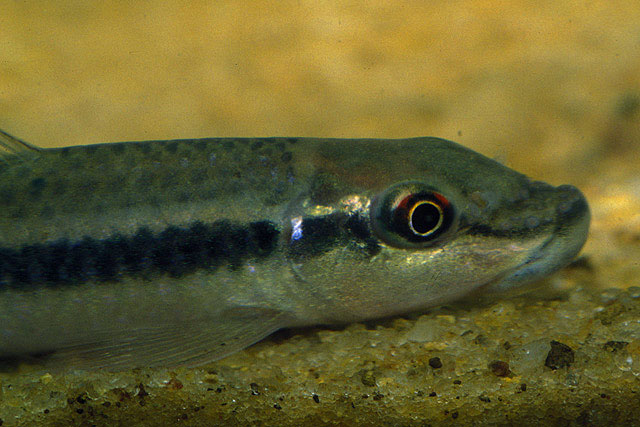| Cyprinidae (Minnows or carps), subfamily: Labeoninae |
| 38 cm SL (male/unsexed); max.weight: 40.0 g |
|
benthopelagic; freshwater, potamodromous |
| Africa: widespread, from West Africa, including coastal basins, Lake Chad and the Niger river basin (Ref. 2801, 81282) up to the Congo River basin (Ref. 2801, 2940). Widespread in the middle and upper Congo River basin (Ref. 26192). |
|
Dorsal soft rays (total): 12-13; Anal soft rays: 8-8; Vertebrae: 29-31. Diagnosis: distal margin of dorsal fin concave; body depth 1.9-3.0x SL; depth of caudal peduncle 0.8-1.2x its length; 24-42 (50-150mm) and 41-44 (150-250mm) gill rakers; scale formula 4.5-5.5/33-38/6.5; 3-4 scales between lateral line and pelvic-fin base; 12-16 scales around caudal peduncle; 9-10 dorsal fin branched rays (Ref. 2940, 81282).
Description: body rather elongate; snout prominent and tuberculate; two pairs of rather short barbels; all specimens examined had 12 scales around caudal peduncle, except for populations from Ogun (14 and sometimes even 16 scales); dorsal fin with concave distal margin in adults and showing allometric growth, the longest ray growing proportionally faster than head length; D:III,(9)10; A:III,5; P:16-17; V:I,8 (Ref. 2940, 81282).
Coloration: back blackish or greyish-green, belly whitish; dark longitudinal band along middle of sides from gill cover to end of caudal peduncle, bordered in live specimens by light yellowish bands; fins tinged with yellowish-pink; the above colour pattern is characteristic for juveniles or medium-sized individuals; pale bands bordering dark mid-lateral band tend to disappear after death, as well as in large individuals which are more uniformly colored on sides (Ref. 2940, 81282). |
| Found in stony river beds and in mountain pools formed by small brooks (Ref. 4906). Maximum TL was recorded at 51.5 cm (Ref. 12456). |
|
Least Concern (LC); Date assessed: 07 May 2019 Ref. (130435)
|
| harmless |
Source and more info: www.fishbase.org. For personal, classroom, and other internal use only. Not for publication.

